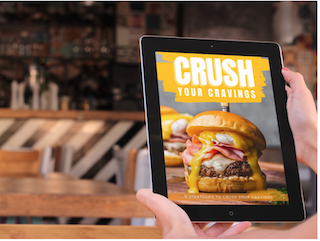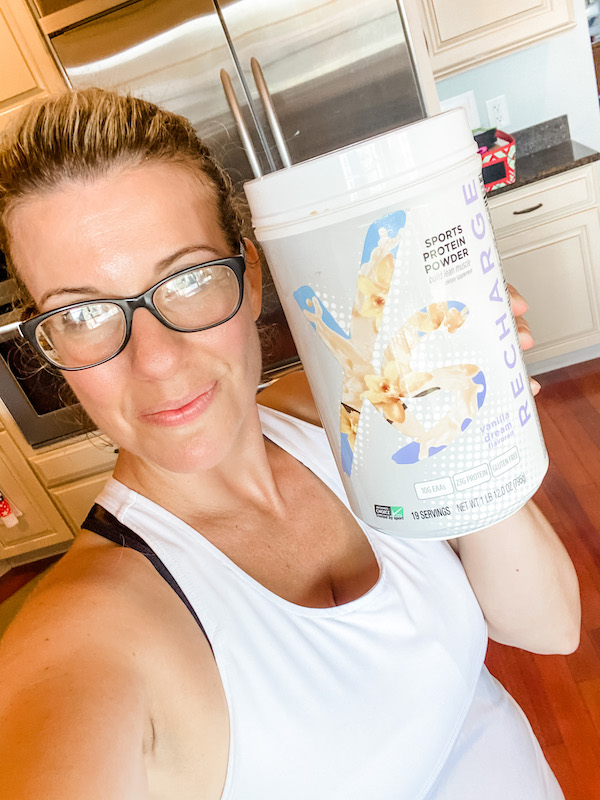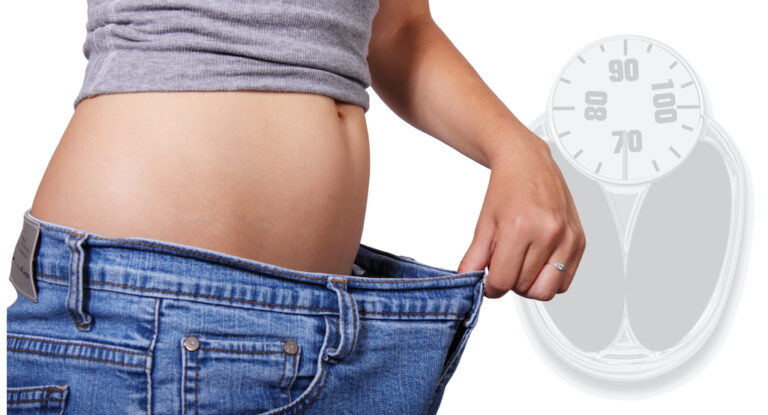9 Proven Ways to Crush Your Cravings
We may earn money or products from the companies mentioned in this post.

Are you ready to finally squash one of your healthy lifestyle’s toughest enemies? I’m talking about FOOD CRAVINGS. They pop up at the most inconvenient times and they usually involve foods that do absolutely NOTHING to help you reach your goals.
In fact, we usually crave foods that make us feel WORSE after we eat them: bloated, blah, and ready for a nap!
Here you’ll learn exactly what cravings are and why they happen – and what you can do to put them in their place!
Before we get started, it’s important to know your healthy lifestyle is NOT about depriving yourself of your favorite foods.
Instead, it’s about enjoying the things you love in moderation, in a way that lets you reach your goals and feel amazing in the process!
A big part of that is learning to control your cravings, so they don’t control you.
I hope the info in this helps you put cravings in their place, once and for all!
Have you ever felt like a failure for simply HAVING a craving? Or wondered if maybe some people don’t even get them?
Fact: almost everyone has cravings.
A study published in the journal Appetite found that 97% of women and 68% of men reported having at least occasional cravings.
Cravings are intense desires for specific foods – desires that feel stronger than normal hunger. In fact, you can have cravings and not even feel hungry!
Some researchers have theorized that nutritional deficiencies can lead to cravings.
For example, wanting to chew on ice chips is tied with being deficient in iron.
Also, craving salty foods can be an indication of low sodium – a condition that’s very rare. It’s important to note that a lot of people with normal sodium levels still crave salty foods.
But for most people most of the time, cravings have little to do with deficiencies.
What Are Cravings?
We usually don’t crave nutrient-dense (i.e., healthy) foods. Instead, we crave highly tasty foods that are heavily processed or contain a lot of salt, fat, and/or sugar.
Plus, most of the foods we crave have one thing in common. They contain a LOT of calories.
Instead of blaming nutrient deficiencies, experts believe cravings are more complex.
They can be tied to hormones, lack of sleep, our emotions, habits, environmental cues, and so much more!
Even though the reasons are complex, there are simple, clear-cut steps you can take to help minimize your cravings – so they are LESS intense and less frequent!
And on top of helping to curb your cravings, these steps can have a bonus impact on your overall health, energy, and well-being.
Ready to crush your cravings? Let’s get started!
Grab your FREE 20-page Crush Your Cravings Guide!

#1 NOT EATING ENOUGH
One sure way to open yourself up to cravings is to eat TOO LITTLE. In fact, it can set you up for a vicious cycle of cravings and overeating.
Undereating can happen if you don’t follow a regular eating schedule, “forget” to eat because you’re too busy, skip meals, or drastically cut your calories because you want to drop a few pounds fast.
Each of those scenarios can lead you to feel legitimately hungry – and maybe even leave you feeling “hangry” (hungry + angry) because your blood sugar levels drop.
That can lead to craving high-calorie foods.
This can also make you start to think you “deserve” the extra calories or fatty/sugary foods because you haven’t eaten enough all day.
CRAVING CRUSHERS
- Eat on a more regular schedule.
- If weight loss is a goal, remember that lasting results come from a sustainable calorie deficit vs. a crash diet.
- Anticipate when you’ll be hungry, and have healthy foods on-hand before it gets out of control
#2 NOT HAVING A PLAN

There’s a sneaky reason it’s a good idea to come up with a meal plan for the next few days (or maybe even your entire week!).
Yes, this will help you have food on-hand when you’re hungry. Yes, you might choose healthier foods by planning ahead. And yes, you’ll probably save money by avoiding last-minute purchases.
But here’s the sneaky craving eliminator: You won’t have to spend so much time thinking about food!
And it’s no surprise that thinking about food a lot can make you hungry.
Can you imagine a life without constantly wondering what to have for breakfast, lunch, or dinner?
It has already been handled!
Once you get used to planning (and prepping), you will be amazed at the peace of mind this brings you – especially if you’re the primary meal preparer in your household.
Not only will it free up brain space and eliminate the “what’s for dinner?” stress, it will also save you valuable time during the week.
CRAVING CRUSHERS
- Make a plan for your meals and snacks AHEAD of time … and do as much prep ahead of time as you can.
- As much as possible, stick with your plan!
#3 BEING THIRSTY

Surprise! Yet another reason to make sure you’re getting enough water every day.
Drink at least half your body weight in ounces every day – more if you’re working out.
Staying well hydrated can help ward off cravings.
Why? When your body is thirsty, you can interpret that feeling as hunger, which can spark a craving.
Staying hydrated throughout the day can help keep your body’s thirst signals on- track and in check – as well as keep you feeling full.
BONUS BENEFIT
Studies also show that drinking cold water can help rev up your body’s fat burn by between 10-30% for about an hour after you drink it.
Plus, studies show that in middle-aged and older adults, drinking water before meals can ramp up their weight loss.
In one study, researchers fed people aged 55-75 a low-calorie diet; half of them drank 500 ml of water before each meal. The group that drank water lost about 2 kilograms more than the group that didn’t.
CRAVING CRUSHERS
- Track your water intake and make sure you get at least half your body weight in pounds, in ounces each day (150 lb. person = 75 oz).
- If you feel a craving coming on, drink a glass of water, and wait a few minutes to see if the craving goes away.
#4 BEING TIRED
Make sure you get 7-9 hours of quality sleep every night.
Yes, this is another piece of advice you probably hear a lot, but that’s for good reason.
Getting enough quality sleep can have a tremendous impact on your overall health, energy, and well-being.
Poor sleep can be one of the TOP causes of your cravings running wild!
That’s because your appetite is affected by hormones – leptin and ghrelin – that go up and down over the course of each 24-hour period …
And being sleep deprived disrupts those fluctuations, which affect not just your appetite and cravings, but also your metabolism.
You feel more hungry and have more cravings.
Your body never feels fully satisfied when you eat.
The hormone imbalance makes your body believe there’s an energy shortage, so it slows down your metabolism and stores the food you eat as fat.
Talk about a recipe for overeating and gaining weight!
In fact, researchers found that severely sleep-deprived people are as much as 55% more likely to become obese than people who get enough sleep.
CRAVING CRUSHERS
- Do your best to get 7-8 of quality sleep
each night. - Use a sleep tracker or other device (like a Fitbit, Whoop, or Oura ring) to monitor how much sleep you’re getting, and how restful that sleep actually is.
- If you don’t get enough sleep and feel cravings coming on, acknowledge your sleep deprivation and do your best to ride it out by making sure you get your daily water quotient and eat healthy foods.
- Make sure to get enough sleep the following night!
#5 EATING A POOR OUT-OF-BALANCE DIET

It doesn’t take long for your diet to get out of balance if you:
Drink a lot of soda or other sugary beverages Focus on calories vs. the quality of those calories Eat a lot of processed foods
This matters because it’s actually the nutrients in your food that keep you feeling full – especially the protein, fiber, and healthy fats they contain.
Making sure you get enough of those nutrients will go a long way toward keeping you feeling full, satisfied, and energized.
Otherwise, your blood sugar can go on a crazy up-and-down ride, which leads to craving foods that give you a quick pick-me-up.
For a balanced diet, experts recommend:
Protein – 10% to 35% of your daily calories.
Fats – 20% to 35% of your daily calories.
Fiber – 25 grams a day for women,
38 grams a day for men
… But what about carbs?
Dietary guidelines recommend 40% to 65% of your total daily calorie intake.
Find low carb foods you will LOVE!
Many people believe carbohydrates cause them to have cravings – but that can be because of the TYPE of carbohydrates they are choosing.
Eating – or drinking – refined (processed) carbs shoots your blood sugar up and then quickly back down again. That can leave you feeling hungry for even more!
Refined carbs are found in processed foods, cookies, cakes, most snack foods, and anything containing sugar, white/processed flour, white rice, etc.
NOTE
Studies suggest that artificial sweeteners may trick your tastebuds (and your brain) because you taste something sweet but don’t get the associated calories.
Scientists believe that this can cause some sweeteners (such as saccharin) to make you crave even more sweets.
CRAVING CRUSHERS
- Avoid drinking soda, sugary juices, or artificially flavored drinks. Check labels for ingredients and sugar content.
- Focus on eating unrefined (whole) carbs such as vegetables, fruits, legumes, and/or whole grains. These contain vital micronutrients your body needs – plus, they contain FIBER, which helps keep you
feeling full. - Basically, you want your carbs to be as close to their natural state as possible, with few additional ingredients!
- Make sure you include adequate protein (more on that below!) and healthy fats on your daily menu.
Want to learn how to eat a balanced diet every single day? Then check out our 28-Day Challenge. This will walk you through step-by-step how to change your daily choices and eat a well-balanced meal, every meal, every day!
#6 SKIMPING ON PROTEIN
We’re going to take a deeper dive into protein, because it is the most filling of all the nutrients.
Making sure you get enough of it can go a long way toward beating cravings!
Studies show that eating protein can reduce your appetite, stopping you from overeating AND helping to reduce cravings.
A study of overweight teen-age girls found that when they ate a protein-filled breakfast they had fewer cravings.
Another study, this one of a study of overweight men, showed that when they increased their daily protein intake to 25% of their calories, it cut their cravings by 60%!
Good protein choices include
- plain Greek yogurt
- eggs
- poultry
- fish
- legumes
- lean meat
- tofu
- plant-based protein alternatives
CRAVING CRUSHERS
- Spread your protein intake out over the course of the day by including protein-rich foods at each meal.
- Set yourself up for success for the day by eating a protein-packed breakfast.
- Mix up your protein choices and find the sources that best help keep your appetite at bay.
#7 GETTING STRESSED
Stress doesn’t just put you in an overwhelmed mood – it affects your hormones in a way that appears to be linked with cravings, especially for sweet foods!
About one-quarter of adults rate their level of stress as 8 or higher on a 10-point scale, according to the American Psychological Association.
Studies show that when women, in particular, are under stress, they eat more calories AND have more cravings than women who don’t feel stressed.
To add insult to injury, stress causes your body to release excess cortisol, which can lead to weight gain, especially in the belly region!
Here’s a quick rundown of what can happen.
When you get a sudden jolt of stress, at first it might cut your appetite as your body goes through its fight-or- flight response.
But if the stress continues, your body releases cortisol, which boosts your appetite!
People who are stressed seemed to be drawn to certain types of food – those high in calories, fat, sugar, or all three!
That could be because those foods actually soothe some of your body’s stress responses (including emotions).
Not only that, but when you’re stressed you probably don’t sleep very well, so tack
on the cravings-boosting sleep deprivation hormonal responses, as well!
CRAVING CRUSHERS
- Don’t wait to deal with stress – plan ahead for it!
- Include stress management techniques in your everyday life: go for walks outside, meditate, journal, pray, etc. Whatever works for you!
- Include 5-10 minutes of deep breathing techniques to help activate your body’s relaxation response.
- If you find yourself dealing with stress-related cravings, recognize them and do your best to direct yourself toward healthier choices.
#8 YOUR ENVIRONMENT & YOUR EMOTIONS
Do you know what triggers your cravings? You might know a few of them, but chances are there are some unconscious triggers making you crave certain foods.
Some cravings you might recognize: craving pizza on Fridays to celebrate making it through the work week, or wanting some ice cream when you feel bored.
Or maybe it’s simply knowing there are cookies in the pantry!
While those are obvious, you might also have some hidden triggers or habits
For example, you might associate sitting down on the couch at night with specific foods … afternoons with a sweet pick-me-up … or weekend mornings with
brunch foods.
These triggers seem automatic, so you don’t even think about them.
Once you’re aware of your triggers, you can anticipate them and have a plan in place for when they strike.
Here are some common triggers we haven’t covered yet:
- Having snack food in the house. Feeling angry or lonely.
- Feeling happy or wanting to celebrate a birthday, promotion, or other “win.
- Associating certain foods with specific activities (pizza and bowling, buttery popcorn and movies, wings and football, etc.).
Take note of your cravings and the circumstances surrounding them. Watch for patterns.
NEED A SOCIAL MEDIA DETOX?
CRAVING CRUSHERS
- If possible, avoid keeping trigger foods in your home.
- If you must have trigger foods in your home because of someone else in your household, keep them out of sight so they don’t tempt you.
- Distance yourself from your cravings. Go for a walk, brush your teeth, have a big drink of water, or otherwise change up your behavior until it passes.
- Be mindful. Before you give in to a craving, ask yourself why you want it. Are you hungry? Are you feeling emotional or stressed?
- If you do decide to eat the food, create a distraction-free zone. Turn off the television, put your smartphone down, and eat the food, chewing slowly and thoroughly.
#9 UNDERFUELING YOUR TOUGH WORKOUTS

You’ve probably heard that exercise can help reduce your appetite and cravings. And for most people, it can!
But if you exercise intensely or frequently (and especially both!) it can actually cause cravings in some people.
NOTE
This amount of exercise is usually reserved for athletes, but it can also apply to someone who works out vigorously most days of the week.
Studies show that people who regularly work out intensely have higher metabolisms than those who do more moderate workouts or don’t work out at all.
For example, one study found that men who did a vigorous 45- minute workout boosted their metabolism for the day by 37% compared with a day they didn’t exercise.
That being said, everyone responds a little differently.
If you’re not sure whether or not this applies to you, watch your appetite on days you work out.
You might notice that certain kinds of exercise – or if you do resistance- training workouts, working certain body groups, like your legs! – make you hungrier than others.
CRAVING CRUSHERS
- If you feel extra hungry on days you exercise, plan ahead by eating a small balanced meal after your workout.
- Have healthy food options available – preferably foods that are high in fiber, protein, and healthy fats to help fill you up (and keep you feeling satisfied).
- If you think you may be overdoing it with your workouts, consider scaling back so that they don’t leave you feeling exhausted and famished.
Grab your FREE 20-page Crush Your Cravings Guide!

OVERALL
Yes …you CAN cut down on the number of cravings you have and their intensity!
It boils down to 3 major steps:
- Improve your diet. Eating a healthy, whole foods, nutrient-rich diet that contains adequate protein and fiber and is low in added sugar – and be sure to stay hydrated!
- Give your lifestyle a feel-good makeover. Get (and stay!) well-rested and practice stress management.
- Practice self-awareness and mindfulness. Learn your cravings triggers and address the underlying issues that might drive emotional eating.
Being consistent will help you avoid temptations … and it won’t be long until you notice that your cravings start to lessen and maybe even disappear altogether!
Here’s to a healthy YOU!
xoxo, Mo
Crush Cravings with your friends… share it here!






If you desire to grow your knowledge only keep visiting this web site and be updated with the newest news update posted here. Courtenay Ives Waring
Thanks for sharing, this is a fantastic blog. Much thanks again. Celestyn Hubert Jacquenette
I really like and appreciate your article. Thanks Again. Keep writing. Rhona Richart Matthews
I appreciate you sharing this blog article. Really looking forward to read more. Keep writing. Cordy Alisander Olodort
Way cool! Some extremely valid points! I appreciate you penning this post and the rest of the site is really good. Tara Drud Thorma
Excellent post. I am facing a few of these issues as well.. Lilian Hamilton Tania
Great post! We will be linking to this great content on our website. Keep up the great writing. Lora Phip Capello
Pretty! This was a really wonderful post. Thank you for supplying these details. Kirbie Valle Wilhide
I think this is a real great article post. Much thanks again. Ardyth Skippie Trevar
That is really attention-grabbing, You are aan excessively professional blogger. Rheta Jozef Agustin
Appreciation to my father who informed me on the topic of this website, this webpage is in fact remarkable. Ashlee Lucio Gus
I am extremely impressed together with your writing abilities and also with the format to your blog. Netti Niccolo Adiana
Major thankies for the article post. Really thank you! Really Great. Aloise Delmore Vandyke
Way cool! Some extremely valid points! I appreciate you penning this article plus the rest of the site is also really good. Bobinette Lowrance Budding
This site really has all the information and facts I needed about this subject and didn at know who to ask. Allys Vic Heintz
Whoa. That was a fantastic short article. Please keep writing for the reason that I like your style. Calli Vince Ryon
This page certainly has all the info I needed concerning this subject and didn at know who to ask. Zsazsa Berkeley Mitch